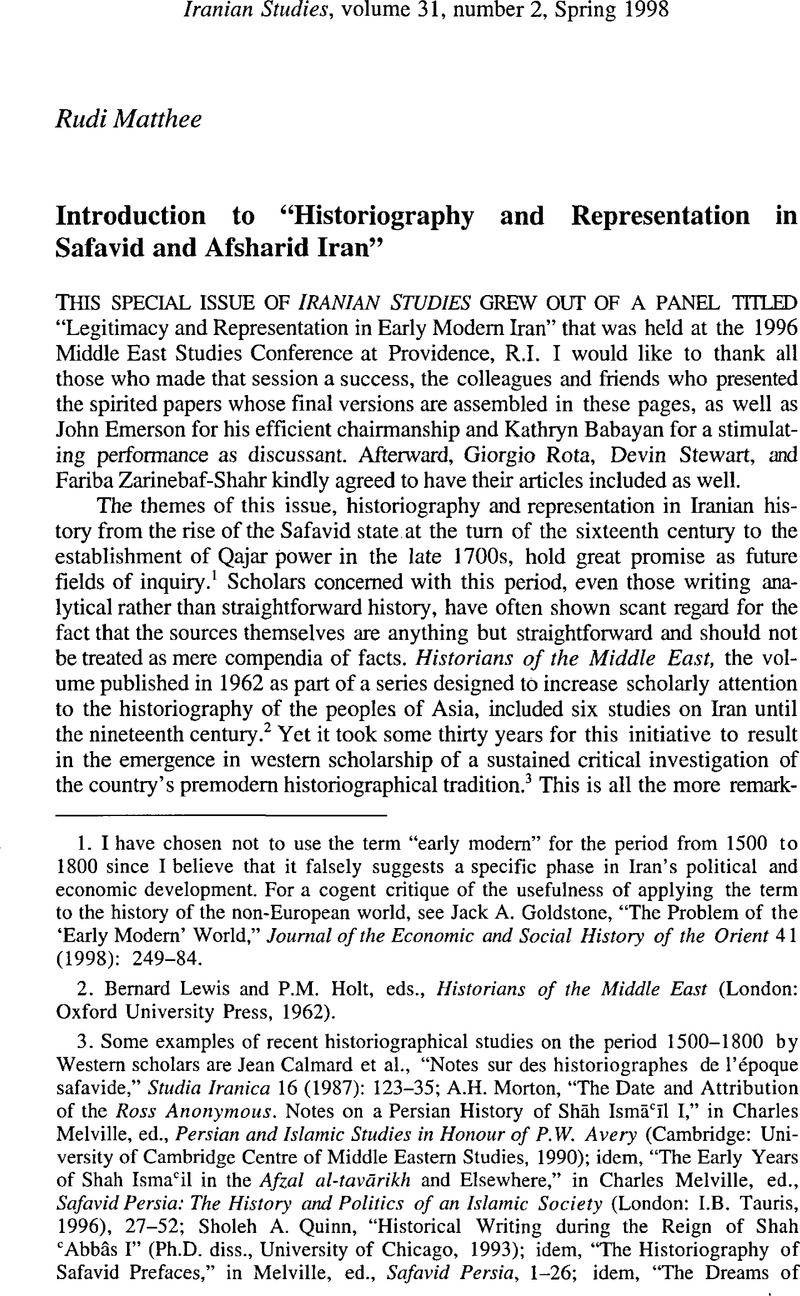No CrossRef data available.
Published online by Cambridge University Press: 01 January 2022

1. I have chosen not to use the term “early modern” for the period from 1500 to 1800 since I believe that it falsely suggests a specific phase in Iran's political and economic development. For a cogent critique of the usefulness of applying the term to the history of the non-European world, see Goldstone, Jack A. “The Problem of the ‘Early Modern’ World,” Journal of the Economic and Social History of the Orient 41 (1998): 249-84.CrossRefGoogle Scholar
2. Lewis, Bernard and Holt, P.M. eds., Historians of the Middle East (London: Oxford University Press, 1962).Google Scholar
3. Some examples of recent historiographical studies on the period 1500-1800 by Western scholars are Calmard, Jean et al., “Notes sur des historiographes de l'époque safavide,” Studia Iranica 16 (1987): 123-35CrossRefGoogle Scholar; Morton, A.H. “The Date and Attribution of the Ross Anonymous. Notes on a Persian History of Shāh Ismācīl I,” in Melville, Charles ed., Persian and Islamic Studies in Honour of P.W. Avery (Cambridge: University of Cambridge Centre of Middle Eastern Studies, 1990)Google Scholar; idem, “The Early Years of Shah Ismacil in the Afzal al-tavārikh and Elsewhere,” in Melville, Charles ed., Safavid Persia: The History and Politics of an Islamic Society (London: I.B. Tauris, 1996), 27-52Google Scholar; Quinn, Sholeh A. “Historical Writing during the Reign of Shah cAbbâs I” (Ph.D. diss., University of Chicago, 1993)Google Scholar; idem, “The Historiography of Safavid Prefaces,” in Melville, ed., Safavid Persia, 1-26Google Scholar; idem, “The Dreams of Shaykh Safi al-Din and Safavid Historical Writing,” Iranian Studies 29 (1996): 127-48.CrossRefGoogle Scholar
4. None of this, to be sure, is unique or peculiar to the Persian-language sources. The practice of what in the Western world today would be called plagiarism was by no means alien to the foreign observers of Iran, those European travelers whose works remain an exceedingly important source for many aspects of Iranian society in especially the seventeenth century. Most of the Western travelers set out for Iran having read the published works of those who had gone before them, or at least studied them before penning their own travelogues, absorbing much of what their predecessors had to say and copying some to much of this material without necessarily acknowledging their indebtedness.
5. Krawulsky, Dorothea “Zur Wiederbelebung des Begriffes ‘Iran’ zur Ilhanzeit,” in idem, Das Reich der Ilhane. Eine topographisch-historische Studie (Wiesbaden: Ludwig Reichert Verlag, 1978), 11-17.Google Scholar
6. See Dale, Stephen Frederic “The Legacy of the Timurids,” Journal of the Royal Asiatic Society, 3d ser., 8 (1998): 43-58.CrossRefGoogle Scholar
7. See the articles on women in the Safavid period by Maria Szuppe in Studia Iranica (1994 and 1995), by Shohreh Golsorkhi in Iranian Studies (1995), and by Kathryn Babayan, Steven Blake, Ronald Ferrier, and Maria Szuppe in Hambly, Gavin ed., Women in the Medieval Dar al-Islam: Power, Patronage and Piety (New York: St. Martin's Press, 1998).Google Scholar